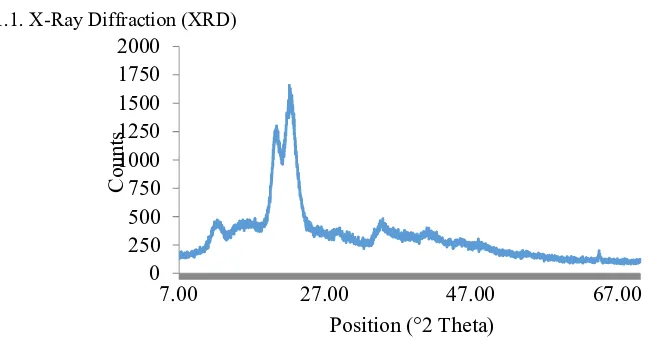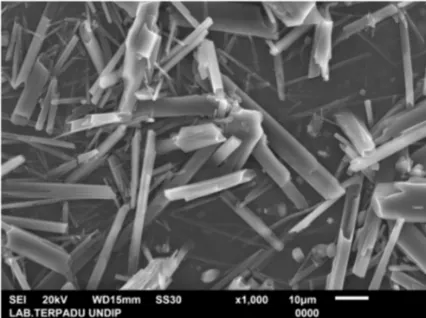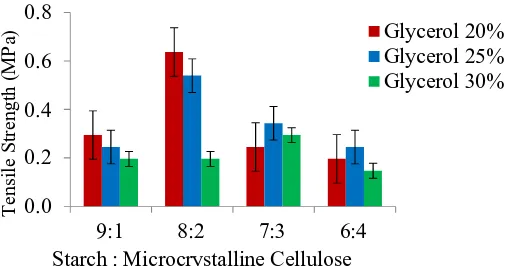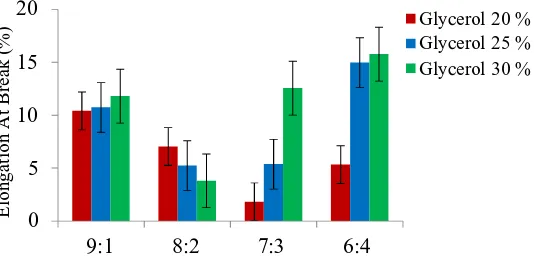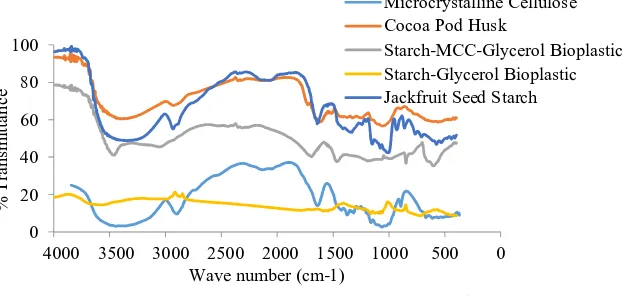All sources 1 41 4 Internet sources 1 11 1
A very light text-color was detected that might conceal letters used to merge words.
Plag L evel:
Plag L evel: selected / selected / o verallo verall
38 matches from 14 sources, of which 14 are online sources.
Settin g s Settin g s
Data policy: Compare with web sources
Sensitivity: Low
Bibliography: Bibliography excluded
Citation detection: No detection
--IOP Conference Series: Materials Science and Engineering
PAPER • OPEN ACCESS
Production of bioplastic from jackfruit seed starch (
Artocarpus
heterophyllus
) reinforced with microcrystalline cellulose from cocoa pod
husk (
Theobroma cacao L
.) using glycerol as plasticizer
To cite this article: M Lubis et al 2018 IOP Conf. Ser.: Mater. Sci. Eng.[4]309 012100
View the article online for updates and enhancements.
1
[4]
Content from this work may be used under the terms of the Creative Commons Attribution 3.0 licence.Any further distribution of this work must maintain attribution to the author(s) and the title of the work, journal citation and DOI.
Published under licence by IOP Publishing Ltd
[6]
Production of bioplastic from jackfruit seed starch
(Artocarpus heterophyllus) reinforced with microcrystalline
cellulose from cocoa pod husk (Theobroma cacao L.) using
glycerol as plasticizer
M Lubis1*, A Gana1, S Maysarah1, M H S Ginting1, and M B Harahap 2
1Department of Chemical Engineering, Faculty of Engineering, University of Sumatera Utara, Medan, 20155, Indonesia
2 Department of Physics, Faculty of Mathematics and Natural Sciences, State University of Medan, Medan, 20221, Indonesia
*Email: [email protected]
Abstract. The production of bioplastic from jackfruit seed starch reinforced with microcrystalline cellulose (MCC) cocoa pod husk using glycerol as plasticizer was investigated
to determine the most optimum mass and volume of MCC and glycerol in producing bioplastics. To produce MCC, Cocoa pod husk was subjected to alkali treatment, bleaching, and hydrochloric acid hydrolysis. The degree of crystallinity of MCC, were determined by XRD, functional group by FT-IR and morphologycal analysis by SEM. Analysis of bioplastic mechanical properties includes tensile strength and elongation at break based on ASTM D882 standard. Bioplastics were produced by casting method from jackfruit seed starch and reinforced with MCC from cocoa pod husk at starch mass to MCC ratio of 6:4, 7:3, 8:[5]2, and
9:1, using glycerol as plasticizer at 20%, 25%, 30% (wt/v of glycerol to starch). [3]From the result, the isolated MCC from cocoa pod husk were in a form of rod-like shape of length 5-10
µm with diameter 11.[3]635 nm and 74% crystallinity. [3]The highest tensile strength of bioplastics
was obtained at starch to MCC mass ratio of 8:[3]2, addition of 20% glycerol with measured
tensile strength of 0[3].637 MPa and elongation at break of 7.04%. Transform [9] infrared
spectroscopy showed the functional groups of bioplastics, which the majority of O-H groups
were found at the bioplastics with reinforcing filler MCC that represented substantial
hydrogen bonds.
1. Introduction
In daily life, plastics are used almost everywhere in the world for various purposes because plastics are inexpensive, readily available, durable and versatile [1]. However, the main raw material in producing plastics derived from petroleum is declining and non-renewable. In addition, the plastics can not be destroyed quickly and naturally by destructive microbes in the soil. This causes the accumulation of waste, pollution and environmental damage [2]. The environmental, economic and safety challenges
have prompted many scientists to replace part of a petrochemical-based polymer with another
2 1234567890‘'“”
TALENTA-CEST 2017 IOP Publishing
IOP Conf. Series: Materials Science and Engineering 309 (2018) 012100 doi:10.1088/1757-899X/309/1/012100
certain limitations. An alternative for a low cost and a renewable substrate has been proposed by using agriculture waste (AW) [5]. essential to increase the strength and toughness of the bioplastic products. The addition of fillers such
as cellulose has been shown to be a very promising material [8]. One of the materials that have cellulose potential is cocoa pod husk which is an agro-industrial waste produced from the cocoa plant (Theobroma cacao L.). Cocoa pod contains 74% fruit peel, 2% placenta and 24% seeds [9]. Cocoa pod husk contains 11% hemicelluloses, 35% cellulose, 15% lignin, 6% pectin, and other mineral elements such as K (3.18%), Ca (0.32%) and P (0.15%) [10]. Also, [13] the addition of plasticizer serves to increase the flexibility of bioplastic. Glycerol is a good plasticizer to reduce the internal hydrogen bonds that will improve the intermolecular distance [11].
2. Materials and Methods
2.1.Materials
Starch from jackfruit seeds obtained from jackfruit merchant in Langsa, Aceh, Indonesia. Cocoa pod husk as raw material for microcrystalline cellulose production is taken from Kampung Padang area, Sei Rampah, North Sumatera, Indonesia. Aquadest (H2O), Sodium Hydroxide (NaOH), Sodium Hypochlorite (NaOCl), from Rudang Jaya Chemicals Store. Acid Chloride (HCl) from Laboratory of Microbiology Engineering, Chemical Engineering, University of Sumatera Utara, Indonesia.
2.2.Producing of Microcrystalline Cellulose from Cocoa Pod Husk
Cocoa pod husk powder of 100 g was inserted into beaker glass then added 1.5 L NaOH 4% and
heated for 2 hours at 100ºC. The residue is filtered and washed with aquadest to neutral pH. The residue is bleached with 2.5% sodium hypochlorite soaked 1 L for 24 hours at room temperature then filtered, and the residue washed with aquadest to neutral pH. The obtained residue added 17.5% NaOH as much as 650 ml then heated at 80 ºC for 1 hour. The residue is filtered and washed with aqua dest to neutral pH. Bleaching with 500 ml of 2.5% sodium hypochlorite and heated at 100 ºC for 5 minutes. The residue is filtered and washed with aqua dest until the pH is neutral. Dried in an oven at 60 ºC for 12 hours. The obtained powder of microcrystalline cellulose was hydrolyzed using 2.5 N HCl by boiling for 10-15 minutes and filtered. The obtained residue is washed to neutral with aqua dest then dried and mashed.
2.3.Producing of Jackfruit Seed Starch
Jackfruit seeds as much as 100 g peeled parts of the outer shell, and its skin then cleaned with clean water. Seeds cut to the size of approximately one cm2 then crushed using a blender with added water.
The mixture is filtered until the resulting dregs and liquid filtrate (starch suspension). The obtained suspension is then deposited for 24-48 hours. The starch-rich liquid then filtered using Whatman filter paper no.1 to obtain wet starch. The precipitate obtained was dried in an oven at 70 °C for 30 minutes. Dried starch powder then sieved with a 100 mesh sieve.
2.4.Producing of Bioplastic
3
mixture was then heated while stirred to a temperature 88,15 oC. The mixture is cooled and printed on
a 25 x 25 x 3 mm acrylic mold. Bioplastic is dried in an oven at 60 oC for 24 hours. Bioplastic is removed from the oven and cooled to be removed from the mold.
2.5.Microcrystalline Cellulose Characterization
2.5.1.[X-Ray Diffraction (XRD5 ] ).
This analysis is performed to measure the crystallinity and the resulting microcrystalline cellulose diameter. This analysis was conducted at Physical Chemistry Laboratory, State University of Medan.
2.5.2.[Scanning Electron Microscope (SEM5 ] ).
This analysis aims to observe the morphology of microcrystalline cellulose from cocoa pod husk. This analysis was conducted at Integrated Laboratory, Diponegoro University, Semarang.
2.6.Bioplastic Mechanical Test
2.6.1.Tensile Strength.
Tensile strength was measured with GoTech Universal Testing Machine (UTM) using the standard of ASTM D882. Tensile [4] strength was calculated as follow :
Tensile Strength = Max Load × Gravity (1)
2.6.2.[Elongation at Break5 ] .
Elongation at break is an indication of bioplastics flexibility, and it's expressed as a percentage. Elongation at break was calculated as follows:
Percent elongation (%)= (Elongation at rupture)
(Initial gage length) × 100% (2)
2.6.3.Fourier Transform Infrared Spectroscopy (FT-IR)
Functional groups of bioplastics were analyzed by using IR Prestige-21 Shimadzu. This analysis was conducted at the Pharmaceutical Research Laboratory, University of Sumatera Utara.
3. Results and Discussions
3.1.Microcrystalline Cellulose Characterization
3.1.1.X-Ray Diffraction (XRD)
4 1234567890‘'“”
TALENTA-CEST 2017 IOP Publishing
IOP Conf. Series: Materials Science and Engineering 309 (2018) 012100 doi:10.1088/1757-899X/309/1/012100
From figure 1. It shows that the absorption peaks of the spectra generated by microcrystalline cellulose
are at 2θ = 12.14°; 20.20° and 22.08°. The value of crystallinity was obtained by calculating the intensity of the XRD analysis using Segal method with the equation below [12] :
100% (3)
The percentage crystallinity of microcrystalline cellulose from cocoa pod husk obtained is 74%, this value is much higher when compared with other non-wood materials (52-53%) [13]. The diameter of the crystal can also be calculated on the results of crystallinity analysis by X-Ray Diffraction using Scherrer's equation with the equation below [14] :
2
. (4)
The absorption peak of the spectra generated by microcrystalline cellulose is at 2θ = 12.14°; 20.20° dan 22.08°. By calculating the crystal diameter of microcrystalline cellulose at the apex of 2θ=22.08° using the Scherrer's equation, the diameter of the crystal was 11.635 nm.
3.1.2.Scanning Electron Microscope (SEM)
Figure 2. Microcrystalline cellulose with magnification 1000x
Figure 2. shows the SEM result of microcrystalline cellulose from cocoa pod husk with 1000x magnification. From the SEM analysis, it can be seen that most of the microcrystalline cellulose from cocoa pod husk morphology of rod-shaped is interconnected with a size of about 5-10 μm.
5
3.2.Bioplastic Mechanical Test Analysis
3.2.1.Tensile Strength
Figure 3. shows the highest tensile strength value is 0.637 MPa for composition ratio of starch: MCC 8:2 with the addition of glycerol 20 %. While the lowest tensile strength value is 0.147 MPa for composition ratio of starch: MCC 6:4 with the addition of glycerol 30%. The addition of microcrystalline cellulose of gelatinization starch film involved grouping of intermolecular hydrogen bonding that causes a molecular bond of amylose in starch more compact [18]. In this case homogeneity of bioplastic is the other important factor of bioplastic with a good characteristic. This homogeneity is related with the solubility of microcrystalline cellulose in NaOH as a solvent.
Kontturi (2015) report that a part of cellulose crystalline could partially soluble in a solution of
NaOH 5-20% after the accurate pretreatment than part of amorphous could soluble in NaOH 4% [19]. In this research, the solution of NaOH 5% (w/v) used as solvent.
Figure 3. The effect of microcrystalline cellulose and glycerol addition on tensile strength of bioplastic from jackfruit seed starch
The amount of cellulose which is dissolved in a solution of NaOH-water depends on polymerization
degree and also its cellulose crystallinity [20]. Based on the graphic, tensile strength at high filler loading (7:3 and 6:4) has declined because the presence of high content of MCC fillers might contribute in retarding the intermolecular interaction of the starch films. This induces the development of a heterogeneous film structure, featuring discontinuities, resulting in the decrease in tensile strength of films [8]. From figure 3. could be seen that the tensile strength value tends to drop with increasing of glycerol volume addition. Because more variation of glycerol added then the tensile strength get lower. This case causes by molecules of plasticizer will disturb compact of the starch, decreasing interaction of hydrogen bonding and increasing the polymer mobility [21]. Molecules of glycerol will disturb compactness of constituents molecules. This condition effected the increasing of edible film flexibility. After that, the elongation and tensile strength of edible film become decrease [22]. [7]But, there is tensile strength in a composition ratio of starch: MCC 8:[7]2 and glycerol 20% increased than it
dropped again. [7]Abdorreza et al (2011) stated that its deviation caused by the ability of plasticizer sustain crystallinity of bioplastic film. The flexibility could increase by the addition of plasticizer, but it also formed plasticizer crystal in film [23].
6 1234567890‘'“”
TALENTA-CEST 2017 IOP Publishing
IOP Conf. Series: Materials Science and Engineering 309 (2018) 012100 doi:10.1088/1757-899X/309/1/012100
3.2.2.Elongation at Break
Figure 4. shows that by the increasing of microcrystalline cellulose mass then elongation at break value of bioplastic will be decreased. While by the increasing of glycerol volume addition, elongation at break value of bioplastic will be increased. The highest of elongation at break value is 15.76% for bioplastic with MCC content 4 g with glycerol 30%. The lowest of elongation at break value is 1.82% for bioplastic with MCC content 3 g with glycerol 20%.
Figure 4. The effect of microcrystalline cellulose and glycerol addition on elongation at break of bioplastic from jackfruit seed starch
Based on the results, it shows that with increasing glycerol addition cause the percentage of elongation also increasing, because glycerol can increase the distance between molecules that make bioplastic become more elastic [24]. The percentage of elongation is inversely proportional to tensile strength. With more fillers added to the plastic film, then the elongation will be dropped, but the tensile strength
7
3.2.3.Fourier Transform Infrared Spectroscopy (FT-IR)
Figure 5 represented the characteristic of absorption peak FT-IR analyze of microcrystalline cellulose of cocoa pod husk, bioplastic from jackfruit seeds starch and glycerol without MCC, bioplastic from jackfruit seed starch with MCC and glycerol, and also jackfruit seeds starch. The dark blue line presented FT-IR spectra of jackfruit seeds starch with spectrum peak that indicate O-H group, C-O-H alkanes, C=C alkenes, C=O aldehyde and C-O eter in jackfruit seeds starch. This FT-IR result are consistent with Maulida research (2016) which is reported same function group with jackfruit seeds starch [27].
Figure 5. Characteristics of FT-IR spectra analysis
The presence of functional group has represented the contents of jackfruit seeds starch which is consisted of amylose and amylopectin and also reducing sugar (C6H10O5)n. The blue line represented the characteristic of absorption peak of microcrystalline cellulose at wave number 3445 cm-1, it indicates the existence of -OH groups and at absorption peak with wave number 2903 cm-1 indicate the existence of H groups which is proved there is H bonding at the end of cellulose structures and C-O carbonyl at wave number 1374.1 cm-1 is also typical cellulose. Orange line represents the characteristic of the absorption peak of cocoa pod husk which has many similarities with
microcrystalline cellulose sample, because of microcrystalline cellulose result is chemical process from cocoa husk, so the groups indicated the existence of cellulose are in similar wave number. The appearance of absorption peak at cocoa husk is 3383 cm-1, 2927 cm-1, 1612 cm-1, 1249 cm-1, 1056 cm -1, and 898 cm-1. On starch-glycerol bioplastic with yellow line could be seen the absorption peak shows that OH groups, C-H alkanes, O-H carboxylates, C=O aldehyde, and C-O carboxylates, is same with bioplastic from jackfruit seed starch with MCC and glycerol with grey line, the appearance of absorption peak is not showing the existence of new groups formation. But, there is an enhancement of
O-H bonds wave number of starch and microcrystalline cellulose 2931.6 cm-1 of starch, become 3001.04 cm-1 at bioplastic, and from 3445.71 cm-1 at microcrystalline cellulose become 3464.15 cm-1 at bioplastic.
4.Conclusion
8 1234567890‘'“”
TALENTA-CEST 2017 IOP Publishing
IOP Conf. Series: Materials Science and Engineering 309 (2018) 012100 doi:10.1088/1757-899X/309/1/012100
[1] Narissara K and Shabbir H G 2013 Greenhouse Gas Evaluation and Market Opportunity of Bioplastic Bags from Cassava in Thailand Journal of Sustainable Energy & Environment. 4 15-19
[2] M. P. Cereda 2000 Characterization of Edible Films of Cassava Starch by electron Microscopy Journal of Food Technology. 91-95
[3] R. Laxmana Reddy, V. Sanjeevani Reddy and G. Anusha Gupta 2013 Study of Bio-plastics As
Green & Sustainable Alternative to Plastics International Journal of Emerging Technology and Advanced Engineering. 3 (5) 82-89
[4] Luc A 2004 Biodegradable Multiphase System Based on Plasticized Starch : A Review Journal of Macromolecular Science. 44 (3) 231-274
[5] Jain R and Tiwari A 2015 Biosynthesis of Planet Friendly Bioplastics Using Renewable Carbon Source J environ Health. Sci Eng 13
[6] J. S Alves, K. C. Reis, E.G. T. Menezes, F. V Pereira and J. Pereira 2014 Effect of Cellulose Nanocrystals and Gelatin in Corn Starch Plasticized Films Carbohydr. Poly.
[7] M. A. and K. Sajjaanantakul 2004 Physico-chemical Properties of Flour and Starch from Jackfruit Seeds (Artocarpus heterophyllus Lam.) Compared with Modified Starches Int. J. Food Sci. Technol. 39 271-276
[8] Maulida, M. Siagian and P. Tarigan 2016 Production of Starch Based Bioplastic from Cassava Peel Reinforced with Microcrystalline Cellulose Avicel PH101 Using Sorbitol as Plasticizer Journal of Physics: Conference Series 710 (2016) 012012
[9] Aji, Dhimas Prasetyo, Sri Utami and Suparwi 2013 Cocoa Pod Husk (Theobroma cacao L.) Fermentation using Aspergillus niger and its Effect on VFA and N-NH3 levels by In-Vitro Jurnal Ilmiah Peternakan. (3) 774-780 1
[10] Hutomo, Gatot S., Djagal W. Marseno, Sri Anggrahini and Supriyanto 2012 Synthesis and Characterization of Sodium Carboxymethyl Cellulose from Pod Husk of Cacao (Theobroma cacao L. African Journal of Food Science) . (6) 180-185 6
[11] T. H. McHugh and K. J. M 1994 Sorbitol vs Glycerol Plasticed Whey Protein Edible Film : Integrated Oxygen Permeability and Tensite Property Evaluatio J. Agic Food Chem. , no. 2 4, 841-845
[12] Segal, L., J.J. Creely., A.E. Martin and C.M. Conrad 1959 An Empirical Method for Estimating the Degree of Crystallinity of Native Cellulose Using the X-Ray Diffractometer Textile Research Journal
[13] M. S. Jahan, A. Saeed, Z. He and Y. Ni 2011 Jute as Raw Material for The Preparation of Microcrystalline Cellulose Cellulose 18, , no. 2, 451-459
[14] Leroy Alexander and Harold P. Klug 1950 Determination of Crystallite Size with the X-Ray Spectrometer Journal of Applied Physics 21, 137
[15] Y. Habibi, L. A. Lucia and O. J. Rojas 2010 Cellulose nanocrystals: Chemistry, Self-Assembly, and Applications Chem. Rev. 110, no.6, 3479-3500
[16] Sumaiyah, Basuki, Wirjosentono, Karsono, M. P. Nasution and Saharman G 2014 Preparation and Characterization of Nanocrystallone Cellulose from Sugar Palm Bunch (Arenga Pinnata (Wurmb) Merr.) International Journal of Pharm Tech Research. , No. 2, pp 814-820 6 [17] N. A. Bhimte and P. T. Tayade 2007 Evaluation of Microcrystalline Cellulose Prepared from
Sisal Fibers as a Tablet Excipient : A Technical Note AAPS PharmSciTech, 8, no.1, pp. 1-7 [18] S. M. Lii, C.Y and Chang 1981 Characterization of Red Bean (Phaseoulus Radiatus Var. Aurea)
Starch and Its Noodle Quality J. Food Sci. 46
9
[22] R. Malaka, M. Taufik and U. Hasanuddin 2014 Effect of Percentage Variation of Glycerol as Plasticizer on the Mechanical Properties of Edible Film from Combination of Whey Dangke and Agar pp. 214–219
[23] M. N. Abdorreza, L. H. Cheng and A. A. Karim 2011 Food Hydrocolloids Effects of Plasticizers on Thermal Properties and Heat Sealability of Sago Starch Films Food Hydrocoll. 25, no. 1, pp. 56–60
[24] Nathalie Gontard, Stephane Guilbert and Jean Louis Cuq 1993 Water and Glycerol as Plasticizer effect mechanical and Water Vapor Barrier Properties of an Edible Wheat Gluten Film Journal of Food Science. 58 (1) 1993 : 206-211.
[25] Setiani, W., T. Sudiarti and L. Rahmindar 2013 Preparation and Characterization of Edible Film
of Polybags Bread Starch : Chitosan. Journal of Valence Chemistry 3(2) : 100-109.
Chemistry Department, Faculty of Science and Technology UIN Sunan Gunung Djati. Bandung.
[26] Y. Zhang and C. Rempel 2012 Retrogradation and Antiplasticization of Thermoplastic Starch in Thermoplastic Elastomers Edited, 7th ed., P. A. El-Sonbati and ISBN, Eds. Canada : InTech, pp. 117–134.
